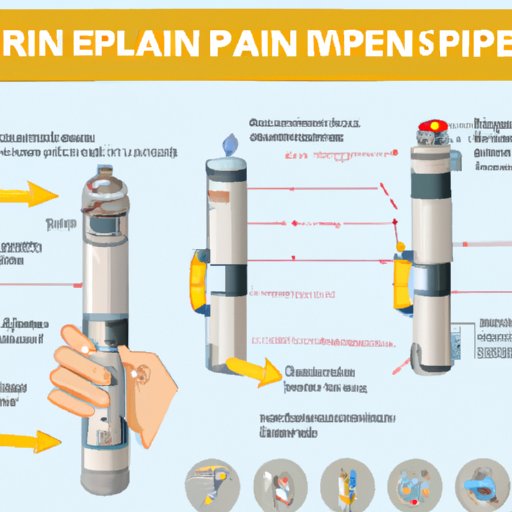Introduction
An EpiPen (epinephrine auto-injector) is a medical device used to deliver a dose of epinephrine, also known as adrenaline, into the body in the event of an allergic reaction. An EpiPen is designed to be used by anyone, including those who may not have any medical training, as it is simple to use and requires minimal instruction. Epinephrine is a hormone that is naturally produced by the body and helps to reduce inflammation in the airways, allowing someone suffering from an allergic reaction to breathe more easily.

Explaining the Functionality of an EpiPen
An EpiPen is designed to be used in situations where a person is having a severe allergic reaction, otherwise known as anaphylaxis. Symptoms of anaphylaxis can include hives, swelling, difficulty breathing, and loss of consciousness. If a person is experiencing any of these symptoms, they should seek medical attention immediately. An EpiPen is used as a first line of defense against anaphylaxis, as it can help to reduce the severity of the reaction and prevent further complications.
It is important for people with allergies to carry an EpiPen with them at all times, as this could potentially save their life in the event of an allergic reaction. In addition, those who suffer from severe allergies should also inform their family members, friends, and colleagues about their condition, and make sure that they are aware of how to use an EpiPen if needed.
An Overview of How an EpiPen Works
An EpiPen is composed of two main components: a syringe and a spring-loaded injector. The syringe contains a single dose of epinephrine, while the injector is used to press the medication into the body. When the injector is activated, the syringe is automatically injected into the thigh muscle, delivering the medication directly into the bloodstream.
The mechanism of an EpiPen is relatively simple. When the injector is triggered, a spring-loaded needle is released from the syringe and pushed into the thigh muscle. This action causes the plunger to move, forcing the epinephrine out of the syringe and into the body. Once the injection is complete, the needle retracts back into the syringe, allowing for safe disposal.

Breaking Down the Anatomy and Mechanics of an EpiPen
The anatomy and mechanics of an EpiPen are complex but important to understand. The device consists of several components, each of which plays an integral role in delivering the medication safely and effectively. These components include:
- Syringe: Contains a single dose of epinephrine.
- Spring-loaded injector: Activates the syringe and forces the medication into the body.
- Needle: Delivers the epinephrine into the body.
- Plunger: Pushes the medication out of the syringe.
In order for an EpiPen to work correctly, all of these components must be functioning properly. Additionally, the needle must be long enough to reach the correct muscle group, and the plunger must be strong enough to push the medication through the syringe.
The science behind an EpiPen is also important to consider. Epinephrine is a hormone that is naturally produced by the body and helps to reduce inflammation in the airways, allowing someone suffering from an allergic reaction to breathe more easily. By injecting epinephrine directly into the body, an EpiPen can quickly reduce the severity of the reaction and prevent further complications.
A Step-by-Step Guide to Using an EpiPen
If you or someone you know is having an allergic reaction, it is important to administer the medication as soon as possible. To do this, follow these steps:
- Remove the cap from the EpiPen.
- Place the orange tip against the outer thigh, above the waistband.
- Press firmly until you hear a click.
- Hold the EpiPen in place for 10 seconds.
- Remove the EpiPen and massage the injection site for 10 seconds.
It is important to remember that an EpiPen is only effective if used promptly. Even if the symptoms of an allergic reaction appear to subside after using an EpiPen, it is still essential that you seek medical attention as soon as possible.
Conclusion
An EpiPen is a medical device that is used to deliver a single dose of epinephrine in the event of an allergic reaction. It is composed of several components, including a syringe, spring-loaded injector, needle, and plunger, all of which work together to deliver the medication quickly and effectively. To use an EpiPen, simply remove the cap, place the tip against the thigh, press firmly until a click is heard, hold in place for 10 seconds, and then massage the injection site for 10 seconds afterwards.
It is important for those with allergies to carry an EpiPen with them at all times, as this could potentially save their life in the event of an allergic reaction. Additionally, it is essential that family members, friends, and colleagues of those with allergies are aware of how to use an EpiPen if needed.
(Note: Is this article not meeting your expectations? Do you have knowledge or insights to share? Unlock new opportunities and expand your reach by joining our authors team. Click Registration to join us and share your expertise with our readers.)
